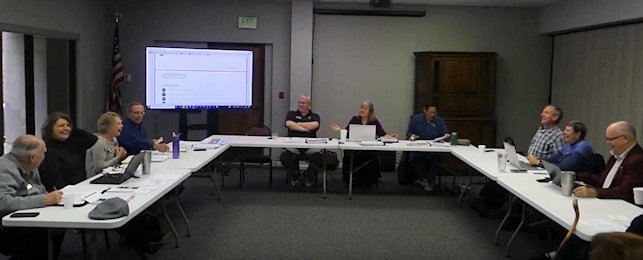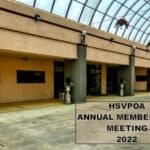By Cheryl Dowden, January 17, 2020
Committee authority
Before we get into the meat of the meeting, I would like to explain the purpose of committees. I am certain that many of you already understand this, but as there seems to be some confusion I thought it would be good to state this. According to Director Nancy Luehring:
“The only committees that have decision-making authority are the ACC and the Audit committees. The Appeals Committee has limited authority. All other committees are advisory committees. They make recommendations and not always are those recommendations put into practice. The Board of Directors is the final governing process with the total right of approval and denial. Any final decisions on implementation are made by staff and lastly the Board of Directors. The committees are invaluable in their dedication and service to the community.” — HSVPOA Board Director, Nancy Luehring
Thanks, Director Luehring for such a good explanation. In a nutshell, this means that any discussion by the Comprehensive Master Plan Advisory Committee is just that and while some of it turns into formal recommendations, the CMPAC does not set policy.
*****
Recap of 1/10/20 CMPAC meeting
CMPAC Meeting Attendees on 1/10/20
The Comprehensive Master Plan Advisory Committee (CMPAC) held its first meeting of 2020 on January 10, 2020. Committee members in attendance were Chairperson, Nikki Choyce; Vice-chair, Rolland White; Secretary, Tom Heau; Pam Avila, Murray Claasen and Clint Blackman. Also in attendance and welcomed by the committee were two new members, Diane Bielanski and Ray Lehman. Committee Member, Jody Latham was absent.
Additionally present were Buddy Dixon, Board of Director Liaison and Stephanie Heffer, Staff Liaison (HSVPOA Director of Placemaking and Development).
Also present at the meeting was the Village Voice in addition to Hot Springs Village People.

What follows is a short recap of the meeting. Accuracy was attempted and hopefully achieved. The link to the video is located at the end of this article.
Choyce has been asked to present a CMPAC progress report at the next Board meeting on January, 15, 2020. (This has already happened at the time of publishing of this article.)
Board Liaison report
Dixon stated they were late in presenting the CMPAC report to the BOD. Director Dixon asked that all committee members attend the next Board meeting – “Just for moral support”.
Update from Stephanie Heffer
Heffer: Staff continues to work on the CMP Implementation Tables and the timeline for future updates. Staff should have all of the changes back to Director Heffer early in the week of January 13, 2020.
Heffer said they are working on a staff “Evergreen Calendar.” This monthly calendar (not day-to-day) is used to make sure staff stays on task with “what needs to be done each month throughout the year, in order to provide the information to the Board.” This information will include the dates of when staff begins the review process for the Implementation Tables as well as when edits are made and other pertinent timing that includes when information is given to the CMPAC, and much more.
Marketing Subcommittee report
Avila said, “I need to know the status of the Recommendations that we submitted when Keith [Keck] was still chair. I don’t know where those are and the Summary of Findings, I don’t know where that is either.”
Choyce responded, “The Recommendations, we did that under…was that the last meeting that Keith was Chair? Or was that the first one that I did. I don’t remember the timing.”
Avila said, “That was the last one when Keith was Chair, I believe.”
Choyce said, “Let me check with Keith because I don’t remember what happened. But normally that would be forwarding it on to the liaison, who would then give it to whoever it needs to be gotten to. But I don’t know what the status is. Do you know?”
Heffer said, “Yeah, it’s been forwarded to staff and Jamie [Caperton] has all of that.”
Update on Siega development
White said it was his understanding that the land for Siega is cleared.
Heffer said, “We’ve actually had some pretty fantastic news – a further commitment from our builder.” Most of the infrastructure is in place, other than the road paving. “Road paving should happen within the next couple of weeks.”… “Our builder already paid for ALL of the permits.”… “This basically paid for the project.” Staff considers this action to be indicative of a complete commitment to the project. It was also pointed out that the permits were purchased at the lower 2019 rates. There are no refunds on the building permits.
Renee Haugen, Director of Real Estate Acquisitions, (from the audience) stated this also helps the builder with the planning of his subcontractors. If a subcontractor finishes one house, he can move on to the next one.
50th Anniversary Kickoff
Heffer: The kickoff is January 28, 2020 at the Coronado Community Center at 3:00 p.m. ReMax is sponsoring the wine and cheese for this event.
CMP revision process review
Choyce: “Last time we started walking through a draft of, we know we’re going to have to revise the CMP documentation, at some point along the way – that process of how that looks. What’s the next step?”
Heffer: “That would be the motion that the committee accepts it as submitted and that you recommend staff take it under advisement and consideration for inclusion in our process for revisions.” The O & M Tables and the CMP Implementation Tables will update annually. The revision of the actual CMP will most likely only occur every few years – three to five years.
Heau: “It looked like the process is aimed at serious updates…” as opposed to items of a routine nature.
Choyce: The committee will also look for typos.
A motion was made and seconded to accept the CMP revision process and unanimously passed.
CMP Growth Prioritization tool evaluation final discussion
Heau emailed all the committee members the final document and did not receive any comments from the members in the past month.
Heau said it is not clear when we are going to have a growth project and when this tool will actually apply.
Avila asked, “Why are we bothering with it then?”
Heau replied, “That is a fine question.” He said it was being done in the interest of completeness. Also, there are similarities to the Amenity Prioritization Tool, so this is practice.
Choyce said, “If you have good tools to support your decision making, you improve your ability to make the decisions.”
Heau said it was worthwhile talking about it, but this is a timing issue.
Blackman stated, “What we are doing for the benefit of the public – is by having this tool, we have a very clear format that when we need, when this comes about that we need to start evaluating these things for our benefit, the POA administration’s benefit, for the Board’s benefit and for the public’s benefit, we’re able to show that we have a system in place to fairly and completely examine all of the facts, all of the information that we need to make a fair and reasoned opinion – and be consistent, too.”
This motion was unanimously passed.
CMP review (discussion on Introduction)
Choyce: “At the last meeting, we have started doing reviews of small sections on the CMP documentation itself, with the idea of trying to evaluate the following three things:
- Relevance,
- Any recommended potential changes, and
- Doing a deep dive and understanding the various parts.”
Choyce: “We did not allow a time to actually finish it. That’s on me, last time, to actually finish it. We did one piece of it but we did not finish it so I was hoping that today we could take a look at the Visioning Statement Piece, which is…I did not make a note of what page.”
Choyce: “The visioning statements as they are written on pages 16 and 17 and then there’s a mapping chart that’s on pages 18 and 19. These are things that we did not [indecipherable] cover.”
Visioning statement from HSVPOA CMP pages 16-19
Visioning-statement-pages-16-to-19Choyce said the points on the Visioning Statement are pretty generic. “I guess my discussion point would be, now that we are two years later on this, does this still, are these 18 the ones that the Board and staff still want to do or any?…Have you taken a look at these from a Board and staff point of view to see whether or not we need to update any of these? Are these still relevant? Add more? Take any away?”
Heffer: “Those are the desired outcomes of the plan. Just the plan. They could potentially change as we do revisions to the plan in the future.”
Avila: “Weren’t they sort of the ‘marching orders’ that were given to the consultant?”
Heffer: “That is correct. The plan was devised to accomplish those outcomes.”
Heffer: “The Visioning Statement may or may not be reflected. So you recommended, I think you said that and that became an old business item about taking a look at and maybe recommending to the Board that they revisit the Visioning Statement.”
Heau agreed with Heffer.
Heau: “The Mission Statement, whether you like it or don’t like it, it’s a mission statement. The Visioning Statement, I may have trouble with the content, which simply does not meet the definition of a vision statement.”
The CMPAC committee is not making a recommendation on what the Visioning Statement should be, but merely advising the Board to take a look at it.
Heau made a motion to recommend to the Board that the Visioning Statement needs to be reexamined. The motion passed unanimously.
Blackman: “In summary what this does is help clarify what the committee is supposed to do. Our targets.”
New Business – Transportation
Murray Claasen summarized four pages (41-44) of the CMP. These pages deal with transportation issues in the Village.
Pages 41-44 HSV CMP – Transportation
CMP-Transportation-pgs-41-to-44Claasen: “In my role on the Public Services Committee, with that hat on, I went through and tried to pick out the things that seemed to be most relevant. And at the same time, being true to the overall theme of what the consultants gave us.”
- Over the next 20 years the CMP states growth and change will have a limited impact on existing vehicle patterns.
- With increasing traffic at the west gate, stacking may be an issue.
- Left turns onto DeSoto will be an increasing problem.
- Dendritic Pattern – “means basically a tree and its branches.” There is a main arterial with secondary roads. Those branch out into neighborhood roads. The Village roads have a dendritic pattern.
- The major arterial is DeSoto, which “captures most of the intention of future studies.”
- There are very few options for modification of the roads due to property ownership and topography.
- Public Service staff and the Public Service Committee have been looking at ways to improve the Ponce and DeSoto intersection.
- The committee recommends the use of roundabouts.
- Due to property ownership at the Ponce and DeSoto intersection, there is not enough space for a roundabout.
- The road system is underutilized and will not be overwhelmed in the next 20 years. (Claasen feels we need to keep an eye on DeSoto.)
- The consultants recommended several improvements to DeSoto.
- The consultants recommended 16 intersections that we should take a look at.
- Five four-way stops on DeSoto are recommended. (Claasen said there were no traffic engineers on the consultants’ staff and that traffic studies did not occur.
- Trip capture – the more amenities (shopping, restaurants, etc.) that are located within the gates means fewer trips that the Villagers need to make outside the gates.
- Night driving is more challenging as people age.
- Alternative transportation is recommended. (Uber, Lyft and shuttle buses) (Claasen did not understand how using Lyft or Uber would reduce traffic.) Choyce said she thought these options were for people without transportation.
- Nonvehicular modes of transportation should be considered. This includes walking, bicycling, golf carts, etc.
- The CMP also talks about implementing safety measures such as the double-line striping and reflectors.
- Consider implementing different daytime and nighttime speed limits.
- Prepare to install a new gate at the town center. Along Danville Road is the suggested location of that gate. This would be done to serve the town center.
- Study traffic patterns at the gates and intersections along DeSoto. Identify problematic streets and GIS.
- Fund and correct problematic streets and intersections.
SWOT analysis*
Choyce: “We have been working towards doing the SWOT (Strengths, Weaknesses, Opportunities, and Threats) analysis and it is one of those topics that…The topic was ‘Economic growth, specifically residential growth. Adding 2,500 rooftops.”
Choyce: “I think we are doing a good job on the strengths. That list was pretty long in terms of what we can do. I think that list is fairly complete.”
Choyce: “The weaknesses is not as long as it could be, but I think that we have a good start on that. I would like your feedback on that since we spent the majority of the time working through the strengths and weaknesses. Do we need some more time to work on the Opportunities and Threats before we’re ready to kind of compile that? Or do you feel comfortable with that?”
Choyce: “So I will take it as an action item to draft it up so that we have one paper copy of it and see if there are any other tweaks we want and make sure the wording is correct.”
Avila: “Can we add one thing to it as we are ready to present it? Could we add an introduction on why the focus on the 2,500 rooftops and what that will mean to the Village.”
Choyce asked Avila if she could help draft the intro. Avila agreed to help.
Future SWOT ideas:
- Commercial economic growth
- Revenue opportunities
Amenity Prioritization Tool
Heau: This allows Property Owners to evaluate and compare new amenity types to “turn these projects to the highest benefit and where funds should be spent.”
Heau: The Amenities Prioritization Tool and the Growth Prioritization Tool are pretty much identical. There is a point system that helps to determine which projects have the highest priority.
Heau: It is not known “where the points come from” or why it was decided what number of points determine high, medium or low priority projects.
Recommendations and comments re: Amenities Prioritization Tool
Staff has utilized this tool several times.
Heau: “Representatives of the CMPAC and staff should be appointed to consider and make recommendations to address the following issues.”
- “One of the biggest issues I had and I think anybody should have is that you read these things line-by-line, some of the lines aren’t very clear, either in terms of how you interpret, ‘what’s the definition of purpose’ or ‘what the measure is’? It looks like a lot of the measures are fairly subjective.”
- “You are giving an aura of precision to something that looks to be fairly subjective and I guess maybe that bothers me.”…
- “It is not clear when during the project process you would actually do this and one of the things that was pointed out was that if you look at one of the items, it says, ‘Does the Board support the project?’ So, the question arose, how would the Board essentially approve or not approve the project when the project is early in the idea phase? Is there a little bit of a circular logic there or not? So the suggestion was, ‘should this tool be actually a multi-stage tool that should be applied at different points during the project?'”
- “The other thought was, when we, ultimately, staff is going to the Board and saying, ‘We want a pile of money for a project,’ and it is part of a process that I call a request for funding process and when I think of a request for funding, it tends to include more topics than just the six topics that were listed in this tool. So how do the six topics in the tool relate to an overall request for X dollars?”
- “Should this tool actually have more provisions, more topics included in it? Or how does this tool interplay with those other projects, other things?”
- Heau feels a third-party review is important.
- Heau feels one of the tool’s value is consistency between projects. If you are looking at five projects at once, you can use this tool and compare scores to make conclusions.
Lehman said he was also asked to look at this tool and it seems there were a lot of sign-offs, for example, Board, department heads, and staff. Lehman said, “How can they possibly do that if they don’t know if it meets the requirements of a viable project?”
Lehman also said that the answers could be tweaked in a way where a project might make sense, when it really doesn’t. An unbiased intermediator should look at this. As Heau said, he feels like the CMPAC would be a good intermediator and if it gets past the CMPAC, then it would go on to the Board. Lehman said, “It seems like it is one step when it really should be three.”
Avila suggested it would be helpful it there was a simplified version of this form that people making suggestions could fill out and this may help them evaluate their ideas.
Choyce: “This is a tool within a process. Do we have the process?”
White: “This is a very useful tool within, say, project management process.”
Heffer said this tool does not take the place of good communication and outreach to our public.
Blackman said what he likes about the tool is that it answers one of the biggest problems. “There have been folks that have said, ‘Well, we really don’t need this. We don’t want this. This doesn’t make sense for us. It’s one group’s idea.’ NO! If it passes the tool, the same tool that is used for all amenity evaluation, then it is a whole lot better representation of what the group, as a whole, our community as a whole, has decided that we need. That’s a step in the right direction, which is what this committee is all about.”
Heau said the current, “really huge issue” is Balboa, both golf course and clubhouse. The clubhouse options are tear down and replace versus renovate. Heau did not know the tool’s role in this instance.
CMP Amenities Prioritization Tool
Amenities-Prioritization-ToolGuest comments
Chuck Alvord: “I don’t think we heard an answer to the question Pam asked on the stutus of the Marketing Committee’s Summary and Finding Report.
Choyce: “We discussed that at the last meeting. Where we left it at that point, there was some resistance and I said resubmit it to me. I have not seen the resubmission. So who’s ball court? Is that in my court or is that in your court?”
Avila: “I didn’t get that, so it was my error. It is in my court. I will get it to you.”
Melinda Alvord: “On the Siega Project and the 20 permits that were pulled, which I have to assume was done just before the deadline when the new permit fees went into effect. So that probably motivated Brandon a lot. But does that actually mean he is going to start building out all 20 homes?
Heffer said he would not start 20 new homes at once.
Melinda Alvord: “Aren’t there time triggers in the permits?”
Heffer: There are no time limits in the permits until they hit the ACC agenda.
Melinda Alvord: “So there is a little technical, buying some time. I would assume he doesn’t have plans to submit.”
Heffer: He does have some plans. The permits could sit out there for a bit, 18 to 24 months.
Melinda Alvord: “You were talking early on in the meeting about updating things in the CMP. Those of us who have our own copies, will we be provided with those updates?”
Heffer: “It will all be digital at some point.” We will communicate to the public when there is a new version.
Melinda Alvord: “You were talking about the criteria for when a four-way stop is warranted at an intersection. Did Balboa and Baleric actually meet that criteria?”
Claasen did not know the answer to this question as this was before his time on the committee.
Click here to watch the 1/10/20 CMPAC Video
* We are not certain when they conducted the SWOT analysis. They did not do this in a public meeting that we are aware of.
By Cheryl Dowden, January 17, 2020
Thank you for reading. Be sure to bookmark this site so you don’t miss our latest reports. Click here to go to our private Facebook Group.












Tom Blakeman
01/17/2020 — 8:26 am
Much ado about nothing! This committee and the CMP need to be cancelled.
Anonymous
01/17/2020 — 10:19 am
Agreed.
It appears that none of these people actually have any experience in project management, let alone planning, budgeting, or development.
AND … no mention of maintenance of current facilities taking priority, which is a dangerous financial position.
Diane Bielanski
01/18/2020 — 4:48 pm
I have cleared with one of the site administrators to reply to a comment from Anonymous on 1/17 as follows, “It appears that none of these people actually have any experience in project management, let alone planning, budgeting, or development.”
There are two volunteers on this committee who are certified project managers as recognized by the Project Management Institute and Oracle Software. Both of these individuals have completed all the educational, course and business requirements to be certified as per Project Management Institute guidelines. In my case, I have worked as a global project manager in the technology industry for nearly 30 years – serving clients in nearly every industry. Please reach out to me personally if you wish to review my professional resume. Thank you.
HSVP C
01/18/2020 — 5:26 pm
This is true, Diane. But you did not need my permission to post this. You notified me of the misinformation and I agreed with you and suggested you make a post. Thank you for the clarification. – Cheryl
Anonymous
01/18/2020 — 8:40 pm
And you said you were a human resource worker. Is it an online course to be certified by Oracle Software? Is the CMP a software program?
Anonymous
01/17/2020 — 8:32 am
Heau: The Amenities Prioritization Tool and the Growth Prioritization Tool are pretty much identical. There is a point system that helps to determine which projects have the highest priority.
Heau: It is not known “where the points come from” or why it was decided what number of points determine high, medium or low priority projects.
Shouldn’t the price of 1/2 a million $ come with precise instructions on how to use it? Where is The Godfather when you need him? Andres, please send help.
Andy Kramek
01/17/2020 — 9:51 am
Again, I see no mention of the “Quantifying Value” tool. As I pointed out last month, (https://hotspringsvillagepeople.com/what-is-the-cmpac-actually-doing/) this is probably the single most important “tool” in the whole CMP and the only one that is supposed to be specific to Village. Its stated function is to identify, and prioritize, the criteria for what the village needs.
Surely setting, and prioritizing, the criteria for determining what the Village needs would be an important issue. In fact, it may be the single most important issue since, without those criteria how do you know that what you are doing makes sense?
Anonymous
01/17/2020 — 10:29 am
To answer … represents a ‘planned unit development’ on large parcels of property within the boundaries of a large metropolitan area with exceptions to existing zoning and land uses.
“Quite apart from anything else many of these criteria expose my total ignorance – I have no idea what “Development transitions scale toward existing housing” means, or “Over 50% of units create off-site preserve lots (Purchase or TDR)” or even what an “Activity Center” really is.
Clearly the latter two are terribly important since they alone comprise 33% of the maximum possible score. Actually, if you examine the criteria carefully you can, using this tool, generate a “High Priority” project by getting a third-party developer to fund building a high-density mix of cottages and row houses within ¼ mile of an activity center with over 50% of the units creating off-site preserve lots and ignore everything else (including any mention of revenue generation for the POA)!
CCI could/should have included a ‘town center’ in the original plans for HSV!
Phil Lemler
01/17/2020 — 10:20 am
A colossal waste of money …. the observers/guests in the audience seem to have a better understanding/comprehension of the tasks than do the CMPAC members!
Tom Blakeman
01/17/2020 — 11:03 am
Phil, there is little doubt that those on the committee are all ones who initially bought into the CMP idea, support the CMP now and support Ms Nalley, not to mention support the concept of New Urbanism. Otherwise, why would they be on the committee.
If I’m wrong on this then please, CMP Committee Members, step up and identify yourselves.
Phil Lemler
01/17/2020 — 11:43 am
I believe you are correct Tom …
Minn Daly
01/17/2020 — 11:43 am
Cheryl, thank you for this information. HSV is not a member of CNU, only Leslie Nalley is a paying member. As CEO she is suppose to follow the BOD however we have a BOD that follows her rule not what is requested by majority of membership. HSV should not be in the developers business or Real Estate business. CMP was doomed from the start because COOPER was not ever involved in this process nor was membership. COOPER owner of all easements had no input in any development of this project until he won the lawsuit. In fact they were not recognized as the developer of this community. It took a court case & jUDGE to make BOD/CEO understand that they were still in the game long term. As per Frank Leeming’s report we are in the red 2.8 Million, but still this BOD/CEO continue down a path of total financial disaster. They continue with lawsuits, unsettled lawsuits, attorneys that cost money that We can’t afford. We need change in this BOD & a General Manager that thinks for membership & community. We need to elect NEW BOD members that have understanding off finances & top heavy organizations. We need strong minded BOD that loves this community like Tucker, Lloyd & Dick that can stand up & push forward for correcting this community. People who understand That HSV is a GATED RETIREMENT community within 2 counties.
CMP & Governance committee need elimination from the HSV agenda. Hopefull that Judge Phillips will eliminate the astringent covenants that are forced upon HSV & rule that membership should vote on compliance rules. We should all thank Gene Garner & frank Leeming for respect & love of our community an production of facts that we need to know about issues that affect all of us. Minn Daly
Anonymous
01/19/2020 — 9:08 am
We pay for the ceo’s membership in cnu, check the terms of her contract.
John Sowers
01/17/2020 — 12:15 pm
Phil Lemler doesn’t live in HSV; he has moved to Arizona. He initially thought the CMP was a great product, then changed his mind and said he had a better plan that would bring many developers to HSV. He did not participate in providing any input while the CMP was being prepared with resident and volunteer committee participation.
We now have two multi-home developers (Siega and CCI Maderas Courts sites) who tell us they plan to build about 50 more homes total. Most new homes are now being built in the east end of the village by other contractors. We also now have a shortage of quality homes for sale in HSV; it is a seller’s market if their home is reasonably located and has been properly repaired and maintained.
We have about 14,300 residents in HSV and based on 50 to 75 new home starts a year, our population would increase about 125 people a year (50 + 75, all divided by 2 for an average of 62.5 homes a year, and then times 2, assuming two persons per new home). If we assume 2500 new roof tops are the goal, that means about 5000 more residents. Our population would then increase to about 14,675 in three years, 14,925 in five years, 15,550 in 10 years, and 19,300 in 40 years.
Tom Blakeman is anti-CMP. The CMP is a product prepared by professionals that don’t live in HSV, who could be and were objective, who assessed the realities of HSV, and gave us good recommendations about things to do in the future to sustain and improve our village. We paid one time $500,000 to sustain and protect our current infrastructure, homes, and commercial assets valued at over 1.2 billion dollars–or $1,200,000,000. A POA or city without a CMP only has a plan for failure. That $500,000 investment in our future cost each of the over 30,000 HSV resident and non-resident stakeholders about $17 per person.
Right now, the biggest challenges for us POA members are how to maintain and sustain our amenity and key infrastructure assets over the next three, five and 10 years. That means making hard decisions about number of golf courses and golf course repairs, keeping HSV gated and unincorporated, and not losing our great POA employees who plan, operate, and maintain this village 24/7. And assessments and/or infrastructure service charges must be increased. We are the largest gated community in the USA, and we must accept the financial responsibility that comes with that distinction and challenge.
Thanks from John Sowers, volunteer POA Public Services Committee member.
Julie
01/17/2020 — 3:34 pm
The CMP was about $16.95 per person too expensive, then.
John Sowers
01/17/2020 — 6:17 pm
Julie, Do you spend that much every year to insure/protect your home, maybe by a factor of 60?
Anonymous
01/17/2020 — 8:20 pm
John, Your HSVPOA assets estimate is not even 1/2 of the replacement value of HSVPOA assets. How much is your home insurance? Depending on your coverage, it is proportional and about the same as your property taxes. Home insurance and property taxes are proportional to property value. Would it be prudent to pay 1/2 price for your home insurance if you knew that it would only cover 1/2 of the replacement value of your home? Or is it prudent to pay double price for your home insurance knowing that it will not pay double the replacement value?
Is it prudent to promote an unvetted and equally unbalanced plan that will not fit within easements through a positive charade scheme? The word Master in the Comprehensive Master Plan connotates the master-slave relationship. It also illustrates the methods used by masters to take their slaves by trap and then by force.
Moe
01/17/2020 — 3:52 pm
John – which of our golf courses are you recommending we close?? As you stated, hard choices await us and that is one of them. Please let me know your thoughts.
John Sowers
01/17/2020 — 6:19 pm
Moe. Please ask Bob Busse and Dick Garrison. I don’t want to close any courses, but are we willing to pay to keep them viable?
Anonymous
01/18/2020 — 9:12 pm
Are We? Are You John?
Julie
01/17/2020 — 4:05 pm
I am curious as to why you think we need to “not lose” our great employees. Are they leaving? Where else around here can they get a better job with better pay and benefits??
Are you kidding?
How will the CMP that you love so much help retain them?
Why will we need them if we are going to close some golf courses, as you stated?
We may be the largest gated community in the US by area, but we are also the most indebted gated community in the US on a resident per capita basis. Why is that do you think? Must be the hard work of these great employees that keeps us in the red….
By key infrastructure assets are you referring to the Balboa Club? The culverts? The roads? DeSoto Club?
How do you propose to increase the assessments when we have literally thousands upon thousands of property owners who refuse to pay their dues? Might it make more sense to figure that mess out first before saddling current residents with more fees for less?
What do you propose for the increase? Double what we pay now? Or is that not even enough? What fee increases are needed to build a town center and a luxury lodge? I suspect about $450 per month per lot would do it. Is that what you are thinking?
Are you afraid to be specific? Name the courses that should be closed and name your price for the increases you so strongly feel we need. Do it now.
I can tell you one thing for certain…if the “cmp” and the “ceo” both stay in place you can quit worrying about the 5,000 new residents.
John Sowers
01/17/2020 — 6:23 pm
Julie. Yes some are leaving, some from Public services and some from the police department. The economy and growth are good in nearby Bryant, Benton, and Hot Springs; it means good jobs for those with good work skills.
Anonymous
01/18/2020 — 10:19 pm
We have 2,000 new residents since the cmp adopted… that is because 2,000 have left in disgust of your plan.
Robert Busse
01/17/2020 — 1:30 pm
I agree wholeheartedly with the comments and opinions of the above posters. As we know leadership (mainly Nalley) laid out to the consultants what the end results of their Plan was to be. So, as we can see there is a proliferation of ambiguous terms, concepts, tools, processes, etc. that no one knows the meaning of and if interpreted and applied in a variety of ways can lead to just about anything one wants. This committee, through no fault of their own, is clueless as to what they are doing and appears to require direction and answers from the POA, whom they are supposed to be providing guidance and recommendations.
I must qualify my opening statement with the fact that Sowers will down play and criticize any opinion or statement that opposes what the CEO and BOD are doing. And, you can notice, he loves to toot his own horn and pat himself on the back for his supposed knowledge and present service. I will give him cu does on his last paragraph, which he points out the seriousness of getting immediately focused on and taking action on our overall maintenance problems, (golf courses in particular), and making a hard and fast, firm commitment to being a gated community down the road.
John Sowers
01/17/2020 — 6:42 pm
Bob. Very smart and experienced folks like Nikki Choyee, Roland White and Murray Claassen clueless? I’ll let them know your unfounded opinion. What golf course or courses do you want to close and you say you do want to remain gated. This goes again what Frank (remove the gates) and Dick (keep all the courses, or get sued) want? What a dilemma you have. Thanks
Anonymous
01/18/2020 — 10:24 pm
Nikki just moved here this year, another card-carrying member of the new urbanist cult, recuited by the ceo for lack of support within this community, just like the feel good cmeo.
John Sowers
01/18/2020 — 12:07 am
Bob. So Nikki Choyce, Roland White. And Murray Claussen are clueless about what they are doing? Please contact them personally and explain again how you came to that conclusion. Also suggest you try a book by Dale Carnegie titled How to Win Friends and Influence People. And I do appreciate opinions based on research, logic, reasoning, and facts—not shoot from the hip emotional comments.
And will Frank (who wants to remove our gates) and Dick (who says we’ll be sued if we close a golf course) remove you from the Monday group? Veracity is very important.
Anonymous
01/19/2020 — 9:19 am
John, take your suggestion and reread the book by Dale Carnegie titled How to Win Friends and Influence People, you are not winning any here.
Phil Lemler
01/17/2020 — 2:23 pm
Mr. Sowers – just one question. Do you think the POA Board, the CEO and the other creators of the CMP knew that HSV easements (CCI ownership) would represent a limiting factor for most of the development strategies of the CMP … BEFORE they paid the $500,000 fee? … or did they find out after?
In other words, did they know the easements were a potential problem?
Was any POA employee or POA Board member advised by any attorneys these easements complicated development in the CMP? Did any of the consultants (DPZ, Crafton Tull, or others) advise the POA that this plan (CMP) would be subject to those easements? Did anyone suggest caution and deliberative review of such a complex plan?
Mr. Sowers, I actually agree HSV needs a CMP. Just not this one.
Ralph
01/17/2020 — 3:54 pm
Phil – I don’t think anyone knew anything before they sprang $500,000 for this absolute wacky “plan” with more double speak in it than 1984 could ever imagine.
John Sowers
01/17/2020 — 6:14 pm
Phil. Of course the POA was aware of what property and rights they held versus those held by others, including Cooper. Negotiating easements, property ownership and financial investment are normal master planning activities. Cooper sells their property and easement rights all the time, which would be easy to verify in county records. HSVs plan was not prepared based on avoiding roadblocks or obstacles or to make the POA a developer. It was prepared to address an underdeveloped and unsustainable community.
The consultants were given a list of 18 open ended deliverables. The only additional direction they received from the CEO was that the plan must be based upon the community remaining a gated, private and unincorporated (i.e. not a city) community. The one deliverable that hangs up most people is the town center, which was placed in there in honor of John A. Cooper’s original design which called for a town center. Every community has a “town square”, “town center”, “heart of the community” and any other word you want to use for its known gathering place. Many of the charette participants also cited that as needed. Doesn’t HSV deserve the same, in its own unique style?
Julie
01/17/2020 — 6:57 pm
It has already been pointed out that HSV has two town centers. Both are failures. How will a third one help?
Please explain as you seem to know a lot more about all this than the rest of us do.
Thanks.
Tom Blakeman
01/17/2020 — 7:39 pm
Hey John,
Send me a copy of all those “open ended deliverables” you mention. One was to figure out where to put a town center. That doesn’t sound open ended to me. When and who decided we actually needed or wanted a town center anyway? Was it Twiggs, Nalley or who? It wasn’t Cooper, as he already had activity centers in his original plan. Have you ever been to Coronado?
BTW, how’s the crack sealing going? How many miles last year or this? Could have done a lot with half a million smackers, couldn’t we?
John Sowers
01/18/2020 — 12:30 am
Tom. Get Frank and come to our next volunteer Public Services committee working meeting at 8 a.m. on Thursday, February 13, 2020, and we’ll tell you all about our past, present, and future crack sealing projects. The meeting only normally lasts for four hours. And road crack sealing is done by POA public services road maintenance personnel, and contractors, and we will tell you why and how much it costs. And it is only one of many road repair and maintenance techniques, and we can talk about those too if you want. And we can also talk about our HSV water system losses and timber sales. And please tell Frank that our roads are not ticking time bombs. We just surveyed all those on the west end recently. Thanks
Tom Blakeman
01/18/2020 — 6:16 am
John, Just answer the questions asked. Otherwise you contribute nothing to the conversation.
HSVP C
01/18/2020 — 7:20 am
John, thank you for this information. You are on the Public Services Committee, aren’t you? Why don’t you write an article with this information so it can be more widely shared with many people? You could make it a series, tackling one subject at a time. For example, roads, water system timber, etc. You sound quite knowledgable on these subjects and it would be a wonderful service to the community. My email address is pennywisebuys@gmail.com. Thank you for your kind consideration of this request. Respectfully, Cheryl Dowden
Anonymous
01/19/2020 — 8:58 am
John, tell us about timber sales, the millions of tall pines raped from our beautiful forests only to pay the ceo salary.
Phil Lemler
01/17/2020 — 7:40 pm
Mr. Sowers – so you admit the POA KNEW of the easement challenges BEFORE they spent the $500,000. This seems like a decision-making process that exposes the inexperience of the CEO and the POA Board.
Negotiating easements is a normal master planning activity. However, you normally negotiate with various individual entities across an entire project (one individual easement owner’s decision does not affect any other easement owner’s decision) . Rarely do you have a scenario, such as here, where one entity can render the CMP development impossible. In HSV’s case, the CMP proposes development of over 26,000 acres where ALL the easements are held by one entity (CCI). If CCI cooperates, the CMP can move ahead. If CCI chooses to resist, the CMP dies. CCI should have been involved or the POA should have gone back to the drawing board.
Why would the POA approve this on such a do or die basis? This is a reckless and unacceptable gamble of HSV.
An investigation into who made the decision to implement the CMP ANYWAY (even in the face of an impossible easement challenge) … needs to be performed. Someone made a HUGE mistake!
John Sowers
01/18/2020 — 12:35 am
Phil. You now live in Arizona. Is it cheaper and better to live there than in HSV? Do you live in a POA community; if so, I’ll bet the long gone developer doesn’t have a bull ring in your nose.
John Sowers
01/18/2020 — 7:08 am
Phil. Again, you live in Arizona. We shot our legs off by not voting to get Cooper’s bull ring out of our noses. Tom led that disaster, and you were supporting him. I assume you still are a HSV property owner when calling for an investigation. Thanks
Anonymous
01/18/2020 — 10:31 pm
John, you have no leg to stand on, to begin with, to shoot off. Your effort to embezzle HSV has failed and will be forgotten history in 2020.
Anonymous
01/19/2020 — 9:04 am
Don’t we already have the “Village Square”? Your plan and your master are ludicrous to think we could support another.
Anonymous
01/17/2020 — 9:31 pm
Phil and Tom you are attempting to speak for Cooper Communities. Stop manufacturing conflict. Your services are no longer needed.
John Sowers
01/18/2020 — 7:25 am
Anonymous. They have always been manufacturing conflict, and both hide behind that it is “only their opinions”. They have duped and created a following of HSV residents by strongly implying that POA board members and the CEO are evil, and making exaggerated claims of wasteful spending. And the results are written threats to board members, one board member’s vehicle being “keyed”, shouting profanities at board meetings, disrupting board recognition award ceremonies, and having one follower caught putting HSV political flyers on private vehicle on private church property. Please call me; my number is in the phone book. Thanks
Phil Lemler
01/18/2020 — 8:34 am
Mr. Sowers – I am not manufacturing conflict … everything I refer to is right in the CMP! Spend some time reading it and you will begin to discover its fallacies!
I have never said anyone on the board or at the POA is evil. In fact, my position is that they are grossly inexperienced and massively overwhelmed. They can’t help that! I also do not condone violence, vandalism or meeting disruptions.
My position is … and has been … the CMP is a bad deal. And, the POA knows it is a bad deal. I have been told this by board members. Everything being done is about protecting the CMP so the board and POA doesn’t look stupid.
I am trying to stop the POA from throwing away good money!
Anonymous
01/18/2020 — 10:43 am
It would be a mistake to assume there was not an intention to collaborate on projects that make sense. This is no longer a Cooper vs POA discussion. Stop manufacturing conflict.
Anonymous
01/18/2020 — 9:01 pm
This never was a Cooper vs POA discussion, this is a Property Owners vs CMP/CNU/DPZ/CEO discussion. Stop trying to cram what you have down our throats that is the only conflict.
Anonymous
01/18/2020 — 10:36 pm
Punitive fines on your neighbors to increase revenue to continue increasing punitive fines is not working as a responsible plan for our Village John.
Phil Lemler
01/18/2020 — 7:36 am
Mr./Ms. Anonymous – I am not speaking for CCI. If they believe I am they know how to contact me.
My point here is how could the POA pass the CMP knowing they could not develop ANYTHING without CCI’s approval? Do you believe it was reckless to spend $500,000 on something that could be completely disapproved by CCI? Would you not, at least, obtain a letter of intent from CCI that stated a cooperative position regarding the easements in relation to the CMP?
It seems to me Mr./Ms. Anonymous and Mr. Sowers …. this was just one BIG irresponsible gamble hoping things would work out.
I believe this is an obvious mistake and inexperienced move by the POA. I believe you agree with me as you seem to be a bit terse!
Tom Blakeman
01/18/2020 — 9:22 am
Actually Ms or Mr anonymous it is your services which are no longer needed.
Anonymous
01/18/2020 — 11:09 am
Tom you have zero influence over my services. Stop manufacturing conflict.
Anonymous
01/18/2020 — 10:52 pm
You are correct, Tom has zero influence over your services, Tom has several zeros over your services. 30,000, at least 4 zeros of a five digit number.
Phil Lemler
01/18/2020 — 7:24 am
Mr. Sowers – so do you believe that approving, passing and funding the CMP was a mistake BEFORE there was a confirmed answer to the easement challenges?
Phil Lemler
01/18/2020 — 8:35 am
Mr./Ms. Anonymous … how do you answer this question? Or better yet, Ms. Nalley, how do you answer this question?
P.T. Barnum
01/18/2020 — 9:13 am
John S., your accusations against Tom and Phil are blatant lies. It is typical of CMP supporters to avoid discussing hard facts by attacking the messengers. Wherever Phil lives has nothing to do with the question he asked. I am losing respect for you.
Answer the question! Why would the POA approve paying $500,000+ on a Comprehensive Master Plan that is contingent on Cooper’s easement rights being waived?
My question: How did the CEO dupe the board into funding the CMP knowing the plan was flawed due to the easement issues?
Anonymous
01/18/2020 — 11:34 am
Cooper does not need your assistance with property easement rights. Stop manufacturing conflict.
Anonymous
01/18/2020 — 11:58 am
Troll, actually the CEO needs Cooper’s assistance to build her town centers and motels in the village.
Anonymous
01/18/2020 — 10:58 pm
Is this Blackman who thinks he can force CCI to submit to the cmp?
Anonymous
01/18/2020 — 11:32 am
Tom Blakeman you have zero influence over my services. Stop manufacturing conflict.
Andy Kramek
01/18/2020 — 4:19 pm
Well, if we knew who you were, perhaps what you have to say would carry some weight. As it is, why should anyone pay any attention to a person who won’t even give their name when they attack someone?
It takes courage to stand by your convictions, something you obviously lack!
Anonymous
01/18/2020 — 11:03 pm
John, why have you morphed into anonymous?
Phil Lemler
01/18/2020 — 1:22 pm
Mr./Ms. Anonymous – you should listen to Tom.
It seems to me you might be just a little bit irritated. That makes sense since you probably have realized that the CEO and POA have painted HSV into a corner.
The only answer now is “SPECIAL ASSESSMENTS”. More money from the Villagers.
The shame is that it did not have to be this way. You had other alternatives other than reaching into Villager pockets to fund your irresponsible CMP!
Stephen Rust
01/18/2020 — 5:19 pm
John Sowers, thanks for comments. Yes Tom Blakeman is anti CMP as am I. The fact that it was prepared by outsiders, means it is a good plan is ridiculous. We that live in the village know more about what we want than do outsiders. Contrary to what you state about a city that doesn’t have a CMP, has a plan for failure, the truth is that the CMP is a plan for failure in HSV. A little reading of the CMP along with a little common sense, anyone can see that the CMP will not work here.
Anonymous
01/19/2020 — 8:45 am
The ACC is corrupt beyond imagination. Has anyone ever received a building permit without an approved blueprint showing every detail including the location on the lot? And once approved there is a 1-year mandatory completion date. Is this another gimmick to boost the new construction dismal starts numbers? Where is the proof that the POA was PAID by this builder? Or is this another sweet deal where the builder doesn’t have to pay a dime until the home is sold? That means that WE are subsidizing and becoming the DEVELOPER of this Siega project.
HSVP C
01/19/2020 — 8:49 am
Dear Anonymous, you could go down to the POA and request this information. Let us know what you find out.
Lloyd Sherman
01/31/2020 — 10:11 am
I read with great interest the posts in this article and refer those who think the CMP was really a “strategic plan”. It was not. I was nothing less than a setup. John Sowers continues to support a document that attempts to turn the Village from a maintenance organization to that of a development organization. Read the RFP for the CMP for yourself. This document clearly states that the CMP should change the Village to a DEVELOPMENT ORGANIZATION. It goes on to clearly state that the deliverables are to be TOWN CENTER, POCKET NEIGHBORHOODS, and LODGING. None of which could be done without stripping CCI of their declarant rights which was attempted after the $500K was spent. So, it is obvious this money was spent for a pre-determined set of deliverables and anyone arguing the opposite is uninformed. We haven’t spent $500K on this debacle, we have spent millions. Then there remains the fact that if you read the CMP even after their 25 or 30 years, it doesn’t fix our revenue issues. Is that really what you call a strategic plan that is set up for success? We need board-level strategic plans that can be realized; not pie-in-the-sky from consultants who were told what to deliver and knew nothing about our Village nor did they care!
Lloyd Sherman
01/31/2020 — 10:12 am
BTW – You can find a copy of the RFP here: https://hotspringsvillagepeople.com/hsv-breaking-news/